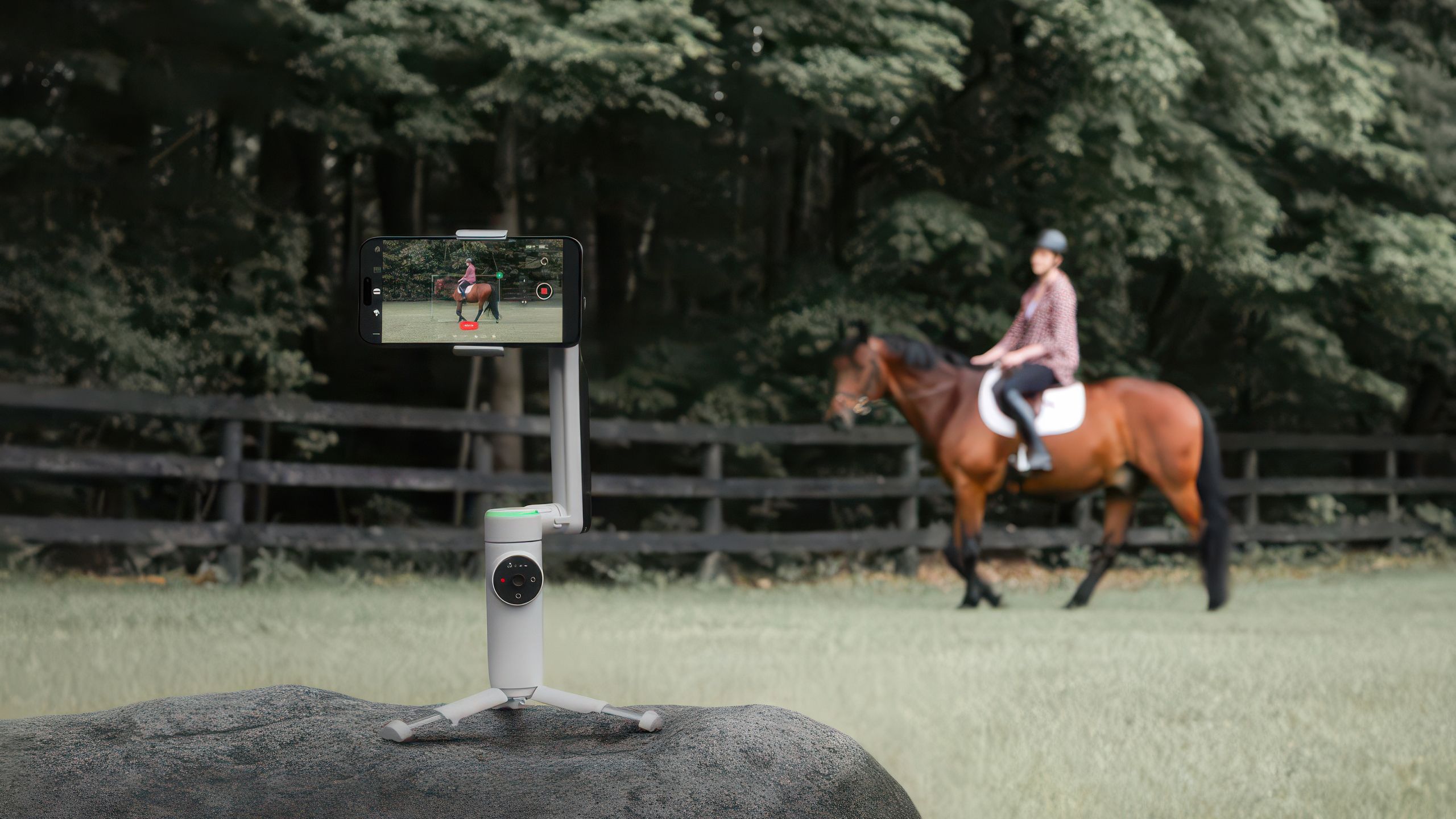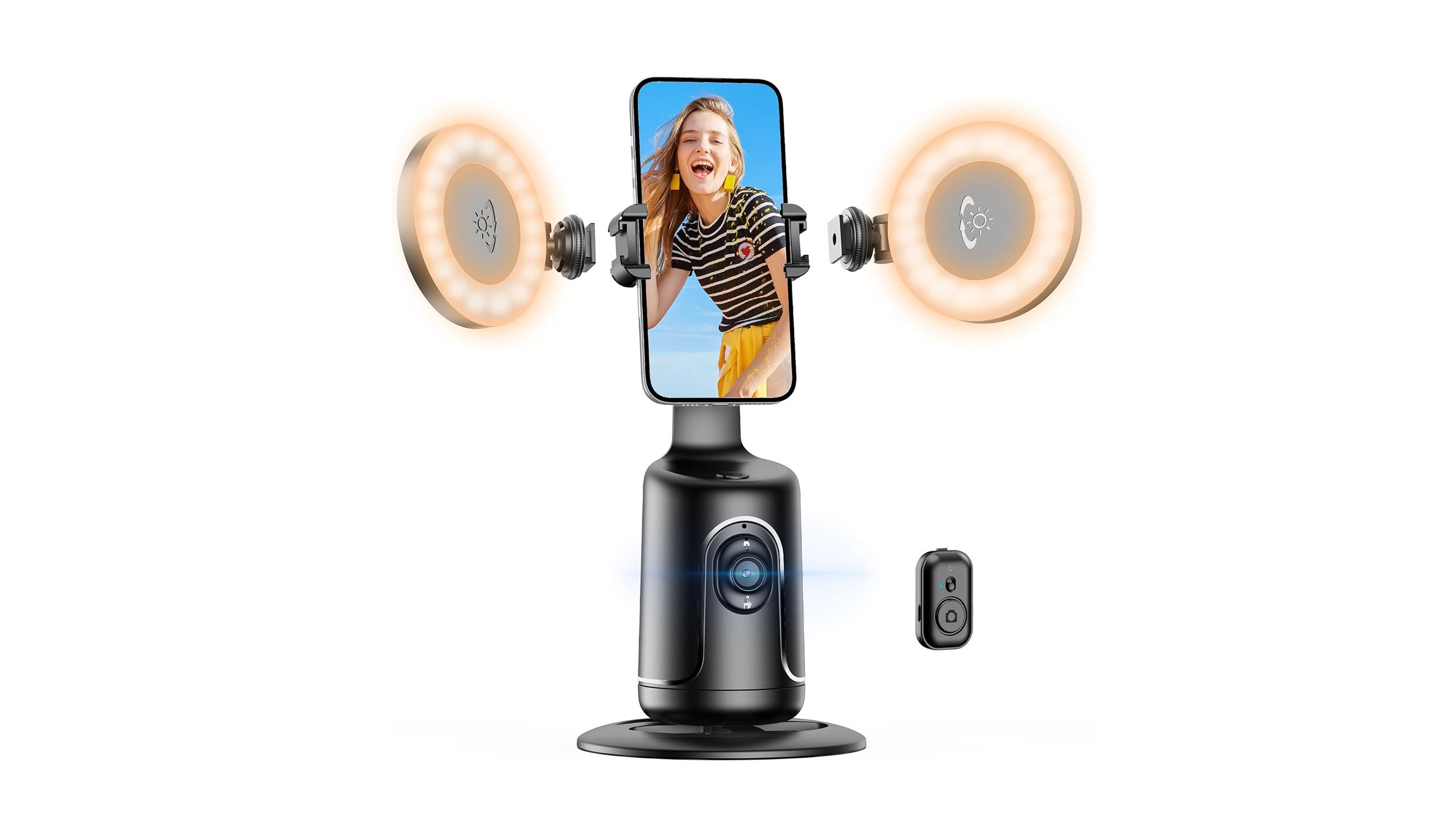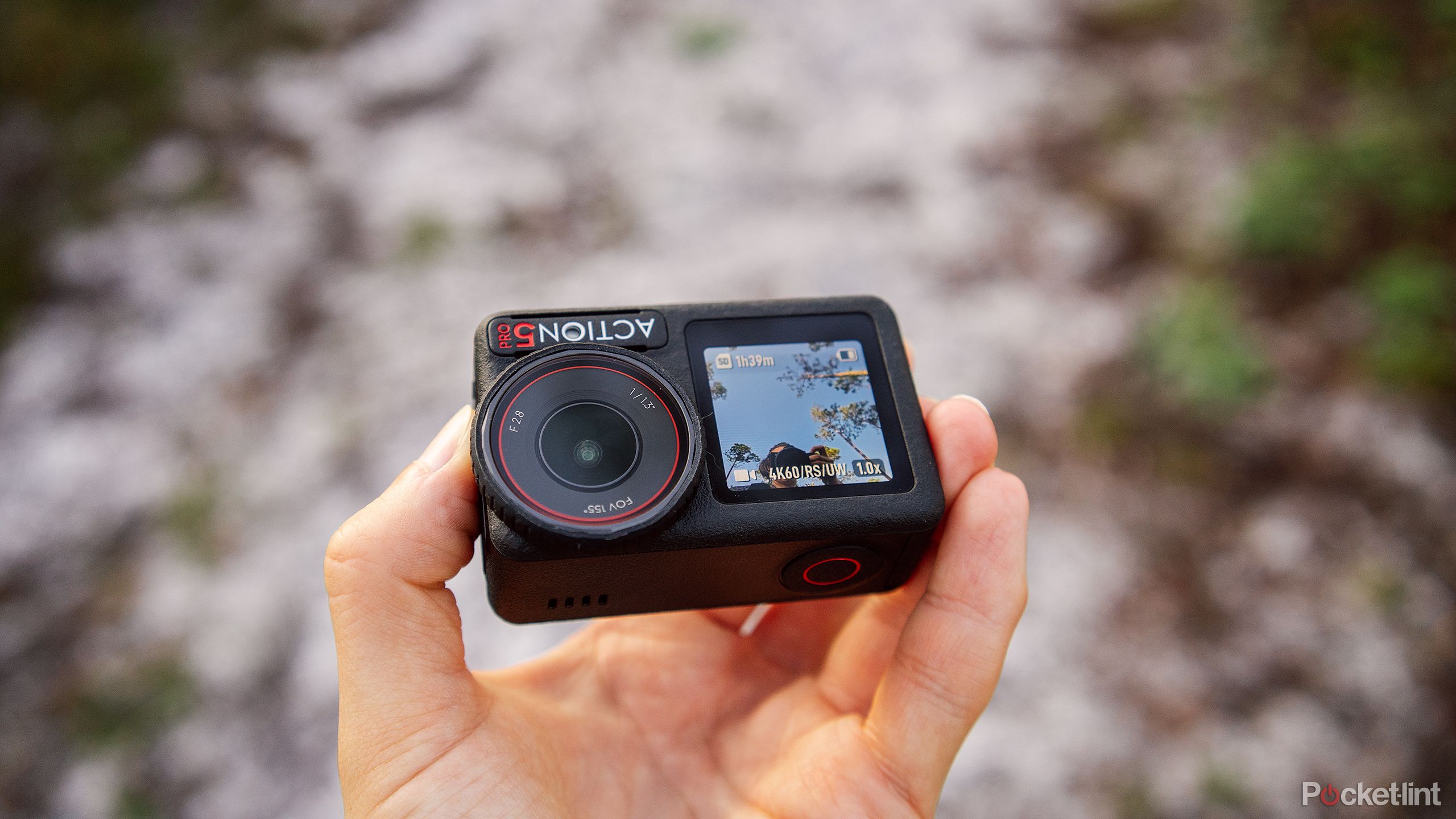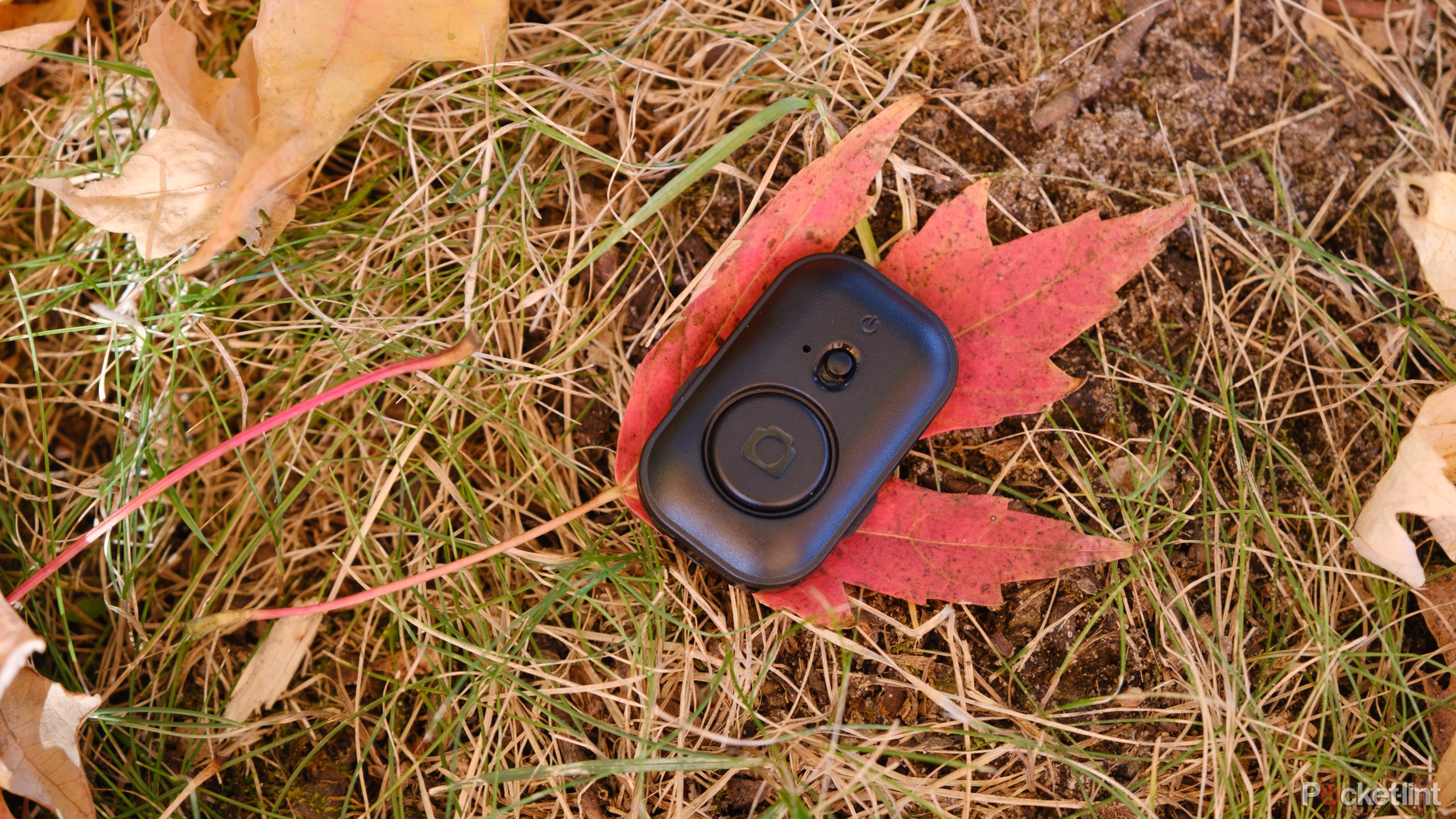Key Takeaways
- SelfieShow Auto Face Tracking Tripod uses facial recognition and a convenient Bluetooth remote to make dynamic vlogs.
- While the noise from the motor may be a deal-breaker for audio-sensitive content creators, it also lacks a tilt function.
- It’s an affordable and easy to use gadget that’s good for basic tracking, but gimbals offer more features for a higher price.
I love my side gig as a photographer, but what I don’t love is recording behind-the-scenes videos of myself. And, let’s face it, the algorithms’ growing preference for vertical video rather than stills means it’s hard to work as an artist without also being a content creator. After a few too many frustrating attempts to record myself, I decided to buy my own personal camera operator: a face-following smartphone holster by a brand called SelfieShow.

Related
Insta360’s Flow Pro is an iPhone gimbal that uses AI to follow you
Insta360’s latest device elevates the iPhone’s already advanced filming features. It also happens to be the first Apple DockKit-enabled gimbal.
The SelfieShow Auto Face Tracking Tripod uses a built-in camera to recognize my face and keep me centered in the frame, which opens up the ability to record vlogs where I’m not limited to standing in one place or begging a friend to help out. The $45 gadget doesn’t need a specific app to work, which means I can record videos from my native Camera app, or inside platforms like Instagram and Snapchat.
But, it’s often the inexpensive gadgets from underdog brands that end up in my box of tech regrets that didn’t live up to expectations. Did the SelfieShow Auto Face Tracking Tripod solve my behind-the-scenes content woes? Or is this a gadget that’s best skipped?

SelfieShow Auto Follow Tracking Tripod
The SelfieShow Auto Tracking Tripod is a smartphone holster designed to keep you centered in the video. Using a built-in camera, it follows you as you move for more dynamic videos. It’s a nice accessory for the cost, but some users will be put off by the noise of the motor and find better results from a gimbal.
- Easy to use
- Decent tracking
- Affordable
- Some motor noise in videos
- Doesn’t keep up with anything faster than a walk
- No tilt function
Price, specs, and availability
The SelfieShow Auto Tracking Tripod has three key parts. There’s the tripod itself, but it also ships with two LED lights and a Bluetooth remote for stopping and starting the recordings. The tracking tripod works in both horizontal and vertical orientations and is capable of following motion 360 degrees. It’s compatible with both iOS and Android.
SelfieShow Auto Follow Tracking Tripod
- Size
- 7″L x 3.7″W x 3.7″H
- Brand
- SelfieShow
- Battery Life
- 5 hours
- Interface
- USB-C
What I like about the SelfieShow Tracking Tripod
The gadget is incredibly easy to use
Straight out of the box, the SelfieShow Tracking Tripod is simple to set up. “Tripod” is a sort of misnomer, as it’s a short gadget that can sit on a tabletop but will require a separate tripod if you want to record footage where you don’t have a table or similar surface available. It ships assembled except for twisting the baseplate to the bottom for tabletop use and sliding the two LED lights into the cold shoe slots. The only slightly confusing part is the two random plastic pieces in the box — I still don’t know what they’re for.
Part of the SelfieShow’s simplicity is the fact that the facial recognition is entirely self-contained. The tripod itself doesn’t require any sort of connection to the smartphone. Instead, the SelfieShow Tracking Tripod has a tiny built-in camera. That built-in camera — not the feed from the smartphone — is how the tripod recognizes and follows people. There’s a “button” to switch from standing to sitting mode, but what this really does is point the tracking camera up or down to ensure it can still see your face.
The tracking tripod also includes a tiny Bluetooth remote, which is small enough to tuck in your hands and keep largely hidden while recording. The included remote requires opening up the smartphone settings to connect to Bluetooth. But, this is for stopping and starting the recording; the tracking tripod itself also works without the remote if you choose to use the screen to start recording instead.
Also included in the box are two LED lights. These mount on both sides of the smartphone in a vertical recording, though you’ll have to remove one to switch to horizontal. The lights have three different color modes to better match with the lights already in the room, then each color mode has a low, medium, and high setting.
Apps that don’t use the phone’s volume buttons to start or stop a recording aren’t compatible with the remote.
Because the gadget doesn’t actually require a smartphone connection, I could choose my favorite recording app. Both the tracking and the Bluetooth remote worked seamlessly inside my iPhone’s native Camera app. The tracking also worked in apps like Snapchat. However, apps that don’t use the phone’s volume buttons to start or stop a recording, including Snapchat, aren’t compatible with the remote. This means you can still use the tracking in those apps, but you can’t stop and start the recording remotely.
The SelfieShow Auto Face Tracking Tripod did a pretty good job following me around for a gadget that’s under $50. It does well keeping track at a walking pace, though occasionally it stops and starts rather than one smooth following motion. It’s also not fast enough to keep up with a run, so it’s not a device for, say, recording yourself doing stunts at the skate park or anything like that.

Related
DJI’s Osmo Action 5 Pro could put mirrorless cameras on notice
The DJI Osmo Action 5 Pro’s upgraded sensor is all about light and dynamic range.
What I didn’t like about the SelfieShow Tracking Tripod
There’s an audible motor buzz in some videos
The first thing that annoyed me about the SelfieShow Auto Face Tracking Tripod is that it has three separate pieces to charge: the tracking tripod itself and the two separate LED lights. Thankfully, all three use USB-C, but there’s only one cord in the box. The Bluetooth remote uses a disposable button battery and isn’t rechargeable.
The motor itself doesn’t tilt — it only pans.
While the SelfieShow’s ability to use any app is part of the charm and simplicity, that design also limits the features. You can’t choose who to follow in a video with more than one person, or tap to follow your hands instead of your face to record a how-to tutorial. This is par for the course in a device that sells for $45, but worth noting.
The SelfieShow is also only designed to track sideways movement. If you move from standing to sitting, for example, it won’t angle the camera up or down for you. You can manually adjust the angle before you start recording, but the motor itself doesn’t tilt, only pans.

Related
I put the GoPro HERO13 Black to the test in the Alaskan wilderness
I took the new GoPro HERO13 Black to Alaska with the Kodiak brown bears for this review — here’s how it did.
The flaw that could put you off of the gadget entirely is the noise of the motor — my iPhone captured a lot of whirring noise. The noise was significantly louder when my iPhone was shooting vertically, perhaps because the weight isn’t as well distributed in this mode. This is a non-issue if you’re recording TikTok videos and plan to strip the audio and replace it with music anyway, but if you want the audio intact for tasks like recording tutorials, the audible buzz of the motor could be a deal-breaker.
SelfieShow advertises gesture control, where making the OK sign with your hands starts the tracking, and palms flat out in the universal stop symbol is designed to keep the tripod in place instead. I couldn’t get these gestures to work — the gadget followed me whenever it was turned on. I didn’t mind not having a stop gesture until I went to try to adjust the lights. The on-off switch is on the back of the LEDs, and you can’t just walk around the tripod to turn them off because it’s designed to follow your face. Instead, I had to turn the device off entirely.
Placing the on-off switch on the front of the lights rather than the back would’ve also made far more sense for a product with “Selfie” in the name.
The audible buzz of the motor could be a deal-breaker.

Related
The DJI Osmo Action 5 Pro is finally a worthy rival of the GoPro
DJI’s latest action camera is packed with useful features and impressive quality.
Is the SelfieShow Auto Face Tracking Tripod worth it?
Perhaps — but if you can afford it, spring for a gimbal instead
The SelfieShow Auto Face Tracking Tripod is the sort of gadget that’ll either be readily loved or quickly abandoned on a shelf of tech that didn’t live up to expectations. Which side the tracking tripod lands on will depend on the type of content you want to record, the features you are looking for, and your budget. It’s a good affordable option for short, audio-free clips, but it fails to live up to the features and usability of pricier smartphone gimbals, which offer features beyond auto-tracking.
Buy the SelfieShow Auto Face Tracking Tripod if you want an affordable way to self-record video without standing in one spot. It’s a good option if you won’t need the camera to tilt up or down, and you’re not bothered by a bit of motor noise in the audio. The simple design, ability to use any app, included selfie lights, and $45 price are all appealing perks.

Selfie Show Auto Follow Tracking Tripod
Avoid the SelfieShow Auto Face Tracking Tripod if you need to record videos with multiple people in the frame, want to follow an object instead, or need to record while moving at a pace faster than a walk. You should also avoid this gadget if you don’t want the hum of a motor in your video audio.
If you fall in that latter camp, consider spending a little more on a smartphone gimbal, which will offer more features and also keep your footage steady as you walk, even when you don’t need the follow feature. Smartphone gimbals like the Insta360 Flow or DJI Osmo 6 offer tracking that both pans and tilts, with dedicated apps for features like choosing who to follow. For the most serious content creators, the self-contained DJI Osmo Pocket 3 offers buttery smooth action and records directly on the built-in 4K camera.

Related
The best smartphone gimbals for stable video
We rank the top options for creating smooth smartphone videos, including products from DJI, Zhiyun, Insta360 and more.





